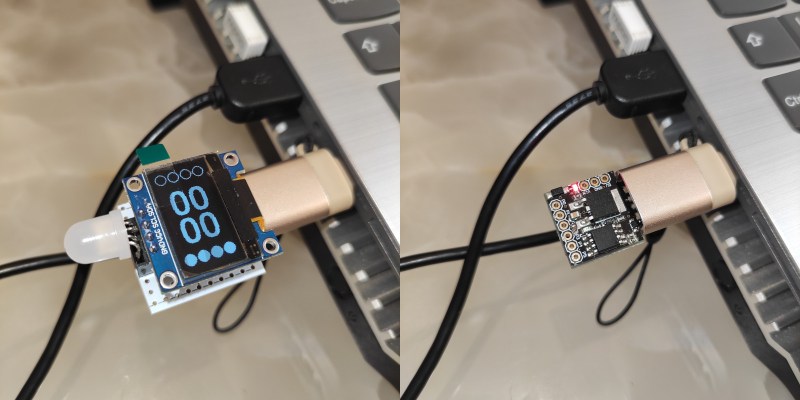If you have trouble staying focused and getting work done, the Pomodoro Technique of working in 25-minute intervals with 5-minute breaks is pretty hard to beat. The only problem is that it requires a lot of input from the user, and all that timer-setting can get in the way of actually getting down to business. The absolute worst is when you find yourself working hard, but see that forgot to set the damn timer (ask us how we know). In essence, the tomato itself can only do so much — you have to actually use it and honor the timer, put in the work, and believe in the system.
 But what if you didn’t have to do as much? With [Erfan Sn]’s design, all you have to do is plug it in to a USB port and the countdown starts automatically. Not only does this Pomodoro timer force you to get with the program, it also makes you take breaks from the screen by putting the computer into sleep mode when the 25 minutes (or whatever time you set in the software) are up. This thing even keeps track of your Pomodoro count.
But what if you didn’t have to do as much? With [Erfan Sn]’s design, all you have to do is plug it in to a USB port and the countdown starts automatically. Not only does this Pomodoro timer force you to get with the program, it also makes you take breaks from the screen by putting the computer into sleep mode when the 25 minutes (or whatever time you set in the software) are up. This thing even keeps track of your Pomodoro count.
At the heart of this build is the Digispark ATtiny85 dev board, which has a handy onboard USB plug. It can be built with or without the OLED screen, which is good if you are easily distracted by the timer itself. This cherry tomato only costs about $10 to make, it’s tiny, and you can take it anywhere.
As you will see in the gifs on GitHub, [Erfan Sn] has it plugged into a female USB-A to male USB-C, which is probably better for the computer long-term, what with all the plugging and unplugging. When we make ours, we’ll probably plug it into a hub that has power switches for each port.
If all of this sounds like too much work, check out this build that senses whether or not you’re in the chair.















I think a software solution that switches you between productive and break desktops automatically would be better with less stress on the USB ports.
Yes. I am also slightly worried about forced sleep during some „mission critical” activity like an unexpected video call with their boss.
Due to the ability to save time, you can disconnect the timer without any worries, then reconnect it at the end of the call, of course, you can also change the times.
And also special thanks to you for giving me a new idea to improve my timer
This is a better solution because the software can not run in sleep mode for counting time
Little tip : Breaks work best when you actually leave room where your computer is ;)
Workrave better SW
thanks hadn’t seen workrave before
but i’m thinking about combining it with this usb pomodoro
This is really creative! When I used to use pomodoro, part of the goal was to be able to get to the point where you were focused and working and could skip the breaks, so I might not have used something like this. On the other hand, failure to take breaks is a pretty unhealthy habit, so as long as your work style can handle it, this is a smart way to enforce it!
+1
There are two sides to this issue.
The first side is physical, whether it’s good to be in the physical configuration for long periods of time. Sitting in your chair or hunched over a lathe or generally being immobile for long periods is bad for you, and this is what the pomodoro is meant to address.
The second side is psychological, whether it’s good to be focused on one subject for long periods of time.
It turns out that focusing for long periods results in a special mode called “deep work” that is simultaneously highly productive and highly pleasurable. It’s very hard to achieve, because it only happens after a long session of concentration, and any distraction will reset your internal timer.
Highly productive people have occasionally discovered this mode over the ages: Neil Stephenson and Donald Knuth are modern examples. Donald Knuth doesn’t use E-mail at all, and goes through and answers his snail-mail correspondence once a month!
https://blog.doist.com/deep-work/
Long-term concentration releases Dopamine in the brain, which is pleasant and builds in level over time, and gets you closer to the deep-work level.
So the real answer is this: tune your work area so that it’s more comfortable, take breaks without losing focus, and practice continuous concentration up to the point where you can do it for hours on end.
This will result in a more pleasurable experience, and (if followed religiously) result in that breakthrough idea you’ve been looking for.
Interesting! Do you have a source for the long-term concentration releasing dopamine? Haven’t come across this and curious to find out more
Check out “Deep Work” by Cal Newport.
https://www.amazon.com/Deep-Work-Focused-Success-Distracted/dp/1455586692
It’s well known that making progress releases Dopamine, and it doesn’t need to be long term to have an effect. Dopamine is an analgesic (literally), which means that it will mask pain, which is why people sit down to do something, get absorbed, and not notice pain building up from poor posture or carpal tunnel or similar.
The long-term build-up effects have been known for awhile, the earliest known reference that I’m aware of is from the “the intellectual life” by Sertillanges (1921). (That’s a religious text and I haven’t read it.)
https://www.goodreads.com/book/show/549384.The_Intellectual_Life
The standard meme is where a monk goes into isolation, meditates for a time (days or more), and gains enlightenment. Christian monks get a calling from God, Buddha sees the universal truth, Joseph Smith writes the Book of Mormon, John Ballou Newbrough writes the Oahspe bible, and so on.
The Dopamine buildup into deep work may be the psychological explanation of this effect.